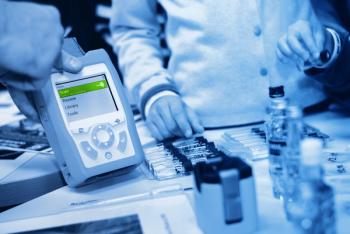
- Spectroscopy-02-01-2007
- Volume 22
- Issue 2
Market Profile: Handheld XRF
Although X-ray fluorescence spectroscopy (XRF) has long been a tool of the laboratory, the past few years have seen a meteoric rise in the use of handheld XRF units for applications in which a portable unit can increase the speed and efficiency of the testing process. Some years ago, handheld instruments required the use of radioactive materials to provide a source of X-rays, but the development of low-power X-ray tubes has enabled this market to flourish by removing any apprehension about using regulated materials.
Although X-ray fluorescence spectroscopy (XRF) has long been a tool of the laboratory, the past few years have seen a meteoric rise in the use of handheld XRF units for applications in which a portable unit can increase the speed and efficiency of the testing process. Some years ago, handheld instruments required the use of radioactive materials to provide a source of X-rays, but the development of low-power X-ray tubes has enabled this market to flourish by removing any apprehension about using regulated materials.
Worldwide XRF Demand, 2006
Originally, the main application focus of handheld XRF was in positive material identification (PMI) tests of metals, such as scrap metals for recycling. Identifying and separating different grades of steel, for instance, could be done easily in the field. More recently, handheld XRF has been identified as an important part of the solution for compliance with environmental regulations like the EU's Restriction of Hazardous Substances (RoHS) directive, which took effect in July of 2006. Although laboratory testing will provide more conclusive results, manufacturers of plastics, metals, and electronic components are rapidly adopting handheld XRF as the first-line screening method of choice.
The total market for handheld XRF grew about 70% in 2006, reaching $126 million. Growth for 2007 should remain well into the double digits, although this pace will soon become more moderate.
The foregoing data were extracted from SDi's market analysis and perspectives report entitled Global Assessment Report, 9th Edition: The Laboratory Life Science and Analytical Instrument Industry, September 2006. For more information, contact Michael Tice, VP of Consulting Services, Strategic Directions International, Inc., 6242 Westchester Parkway Suite 100, Los Angeles, CA 90045, (310) 641-4982, fax: (310) 641-8851,
Articles in this issue
almost 19 years ago
Think Small Revisited: Handheld Spectroscopyalmost 19 years ago
End of the Spectrum: Spectroscopy Plays the Violinalmost 19 years ago
Productsalmost 19 years ago
NIR Chemical Imaging for Counterfeit Pharmaceutical Products AnalysisNewsletter
Get essential updates on the latest spectroscopy technologies, regulatory standards, and best practices—subscribe today to Spectroscopy.





